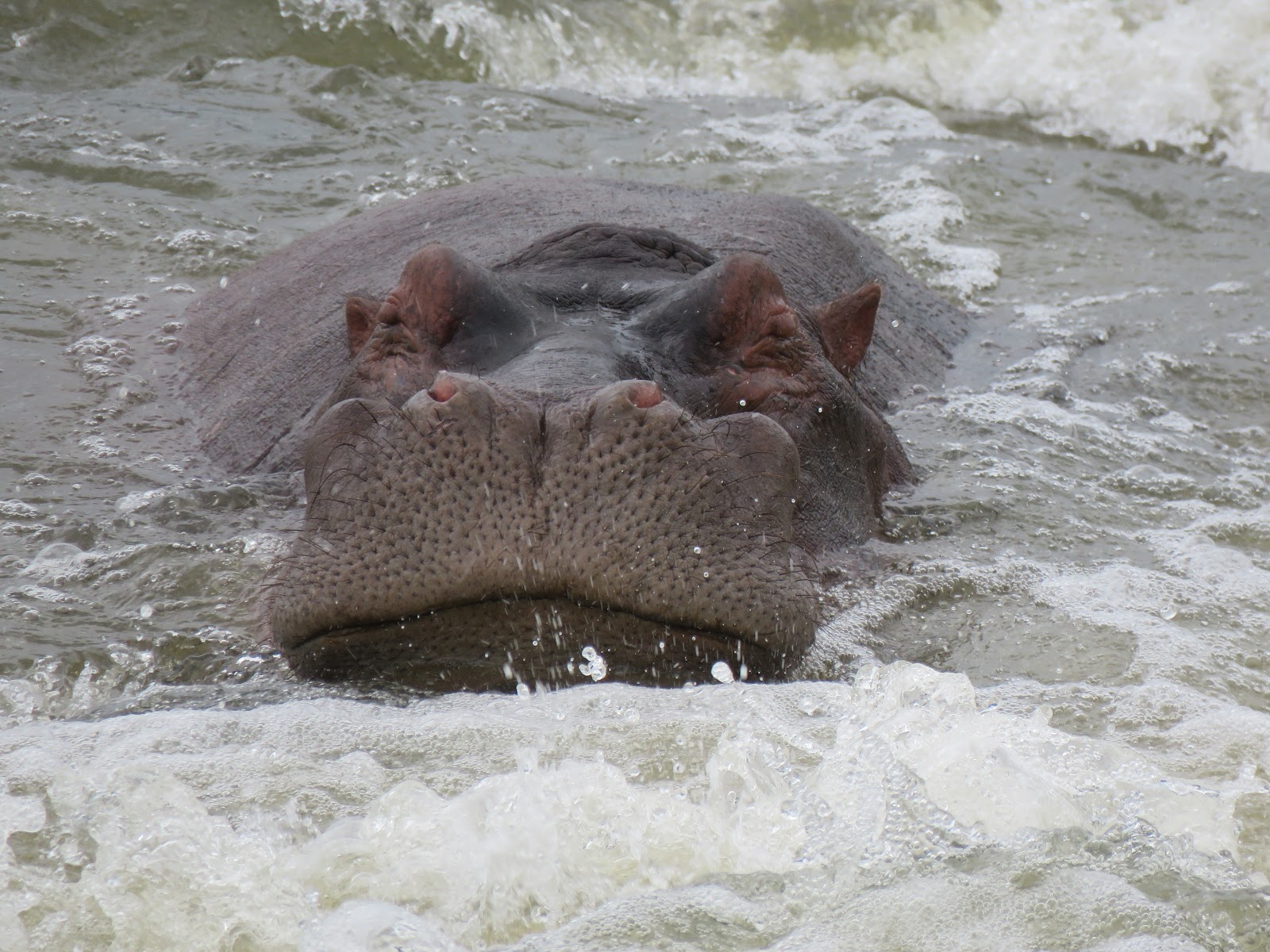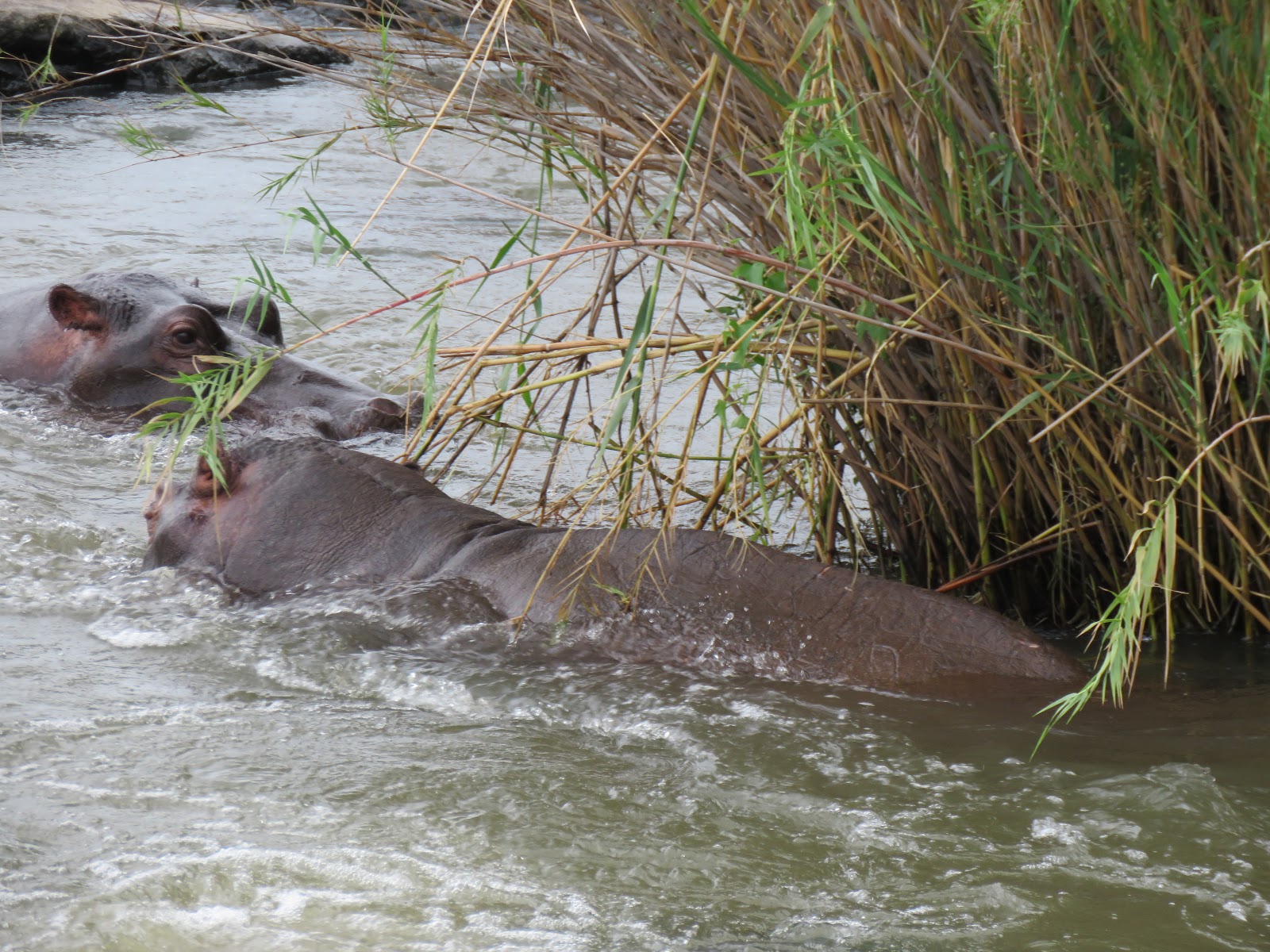 |
| We centered our attention on this particular hippo hoping for a wide opened mouth shot at one point. Unfortunately, he never cooperated, but we enjoyed the close-up photos nonetheless. |
“Sighting of the Day in the Bush”
 |
| An Egyptian Goose on the far shore of the Sunset Dam in Kruger. |
It seems as if each time we visit Kruger National Park, we encounter an exciting scene (to us anyway) that serves as fodder for an upcoming post. Today’s post about hippos proved to fit the bill.
 |
| As we drove across the bridge over the Sabie River, we spotted four hippos in the rapids. |
As we drove toward the Mugg & Bean Restaurant in Lower Sabie a bit earlier than necessary to meet Rita and Gerhard for lunch, we noticed some activity on the Sabie River bridge. We veered off the main road to see what the commotion was all about.
 |
| We shut off the car’s engine to avoid vibration, taking photos for quite some time while we decided which hippo provided the best photo ops. It wasn’t these two. |
We located a good spot to park the car as close as possible to the edge of the bridge, closest to the hippos, to enable us to take a few decent shots, hopefully. With many other cars on the bridge, we were pleased to get an excellent place to stop.
 |
| From time to time, these two hippos moved a little but never enough for unique shots. |
While trying to take photos, we’ve found it necessary to turn off the car. The vibration from the running vehicle has an impact on the quality of the photos. I’ve even noticed when Tom moves to get more comfortable. It can have a bearing on the clarity of my photos.
 |
| Periodically, our star-of-the-day closed his eyes to nap in the bubbling waters. |
It never happened. We realized as we drove away that the wide-mouth shot wouldn’t be necessary after all. Instead, we had an opportunity for the first time to be so close to hippos, hardly needing to use much zoom to acquire the photos we’re sharing today.
 |
| It was a hot day, and he appeared relaxed and at ease in the fantastic rapids washing over him. |
Over these past six years, three months, we especially took an interest in getting closeups of animal’s faces. There’s something magical about the intensity of their looks, expressions, and demeanor that reveals so much of who they are and perhaps, if we’re lucky, how they feel.
As we reviewed these photos, we couldn’t help but find a bit of whimsy in these faces, oddly faces of one of the most dangerous animals on the planet, killing many humans as follows from this site: “Ungainly as it is, the hippopotamus is the world’s deadliest large land mammal, killing an estimated 500 people per year in Africa. Hippos are aggressive creatures, and they have very sharp teeth.”
 |
| From this site: “The hippopotamus, commonly referred to as the hippo, is a round, bald, cantankerous herbivore with a semi-aquatic lifestyle and a fearsome reputation. At 14 to 16 feet and 4,000 pounds, they are as long as a car. The 3-foot skull houses huge, protruding canines, called tusks, contained in a broad, cavernous mouth that can be opened to a gape of 150 degrees – 3 times wider than the human jaw.” |
As dangerous as they may be, for the safari-goer/tourist, they are fascinating animals to observe in the wild, and we’re grateful for the experiences we have had over this extended period spent in Africa.
 |
| The hippo’s skin is gray to brownish-red with pink areas around their ears and under their chin. They have very few hairs on their body but do have stiff whiskers on their broad lips that feel like a broom and a small amount of fuzziness around the edges of their ears and on their tail. |
Today, we had yet another fun party to attend, a bush braai at Frikkees Dam in Lionspruit, a game conservancy inside Marloth Park. We dined on fantastic food with about a dozen in attendance, including a traditional potjie Danie and Louise made with seafood. It was divine, comparable to fine seafood chowder.
Earlier this morning, I made a big pan of an Italian dish for tonight’s dinner. Now, back at the house, none of us are hungry, so we’ll play it by ear. Maybe by 7:00 or 7:30, we will be hungry again.
 |
| “Ah, that splash feels good,’ he moans. Hippos don’t swim, although they spend nearly 16 hours a day wallowing in rivers and streams. When not strolling along the bottom, they propel themselves by pushing off the riverbed, or rocks, driftwood, or other hippos, and gliding along for a distance before pushing off again. |
Linda and Ken are leaving tomorrow. Their week with us has sailed by, and we look forward to seeing us again in February when they return to Marloth Park from Johannesburg for our upcoming going away party, hosted by Kathy and Don. At this point, we’re leaving MP in 25 days.
Have a fantastic evening!
Photo from one year ago today, January 19, 2018:
 |
| Fancy chalk graffiti on the exterior of a cafe in Buenos Aires. For more photos, please click here. |
